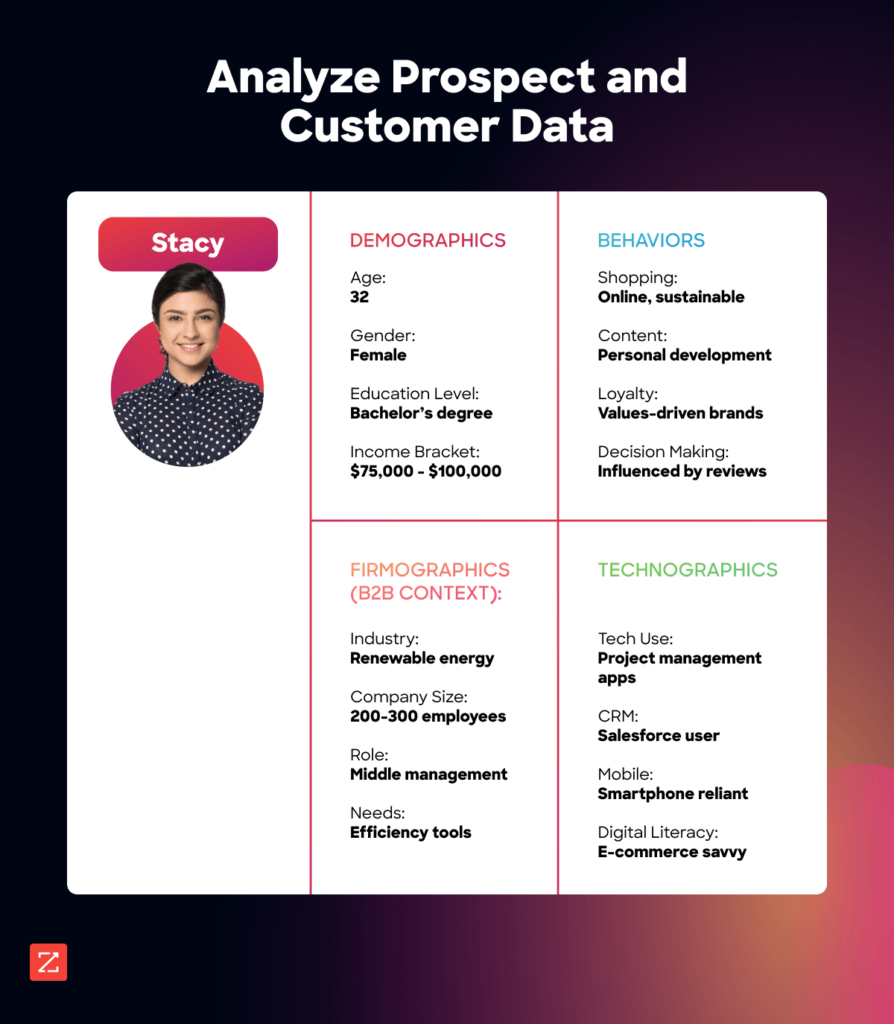Understanding your target customer is key to any successful marketing strategy, and well-developed buyer personas are one of the most effective tools sharpen that understanding.
Well-crafted buyer personas turn disjointed, dry data points into composite characters that your team can more easily identify with, transforming abstract ideas into actionable market intelligence.
Here’s how to craft a winning buyer persona, some examples of personas in action, and ways to leverage those personas for campaigns that drive improvement in your marketing KPIs.
What is a Buyer Persona?
A buyer persona is a detailed profile of your ideal customer. It goes beyond basic demographics to paint a picture of their motivations, challenges, problems, values, and buying criteria. These profiles are fictional representations, but they should be based on real-world data from existing customers and prospects.

Why You Need Strong Buyer Personas
The purpose of creating personas is to ensure that your lead generation and customer acquisition efforts are tailored to the needs of your target customers.
Good buyer personas give your team:
A better understanding of customers: It’s much easier to get inside the minds of prospective customers when you have a complete character to visualize.
Improved focus: With a better understanding of your customers, your marketing team can create messaging that fits their interests.
A smoother customer journey: Tailoring the buying process to the needs of real customers reduces friction. Customers also feel more valued, because even mass-produced marketing messages are personalized.
Smart overall decision-making: Visualizing real buyers through customer personas can bring the potential advantages of each decision into focus.
Higher ROI and conversion rates: These changes usually result in improved lead generation and customer acquisition campaign performance.
How to Build Buyer Personas
Buyer persona templates are a useful starting point, but it’s important to build personas that match the real world. Here are a few examples that you should customize with data from your customer base.
1. Start With the Basics
Mine the data in your customer relationship management (CRM) system to create broad segments based on shared traits among existing customers.
For example, B2B buyer personas could start with data on:
Location
Age range
Education level
Job title and authority level
Company size and industry
Favored websites and news sources
Primary buying motivations and concerns
You can extrapolate and add other information about buyers from these data points, such as content consumption habits and communication preferences.
2. Analyze Prospect and Customer Data
The foundation for any good persona is quantitative research, anecdotal observation, and existing customer data.

3. Explore Different Data Types
Beyond the data collected during your marketing campaigns, other sources of information should inform the personas:
Social media audience data: How people behave on social media can be closely linked to their buying decisions and overall attitude toward marketing messaging. By analyzing audience data on social platforms, you can learn more about your prospects and what they like about your brand.
Customer support records: Following customer support records allows you to identify which prospects get the most value from your solution. Some prospects rarely ask for support, while others struggle to get full value from your product.
Competitor data: Sometimes, it’s worth following your competition. Using audience analysis tools, learn about the audiences that interact with competing sites and social profiles.
Customer feedback: Some of the best customer insights can be found on review sites. These comments provide an unfiltered glimpse of who your prospects are and what they’re thinking.
4. Talk to Current Customers
While data is essential for putting together a buyer persona profile, conversations with current customers are just as powerful.
Customer interviews can be an efficient way to understand how your prospects feel about your brand and products and what matters to them.
Once you know what the majority likes, play around with different approaches to find what resonates with various buyer types. Feed this information back into new B2B personas, which will later inform marketing strategies for different customer segments.
To get enough customers to volunteer for interviews, consider offering a reward to participants. A gift card or minor discount on the next purchase works well.
Do Your Personas Pass the “Gut Check?”
Profiling ideal buyers isn’t an exact science. Even high-quality data can be misinterpreted or simply not align with the outlook of real prospects.
Assess your draft personas before deploying them. Based on everything you know about your customers, do the personas feel right? If something feels off, consider reassessing your process.
Buyer Persona Examples
To understand what a good buyer persona looks like, it’s worth reviewing some examples.
Example 1: The IT Director
Name: Kevin
Age: 42
Job title: IT director at a mid-sized manufacturing company
Lives in: Austin, Texas
Income: $120,000 per year
Media habits: TechCrunch and Wired for tech news; LinkedIn for professional networking; Netflix in his spare time
Buying role: Key influencer
Reports to: Chief technology officer
Also involved: IT team (end users); CFO (budget approval); procurement department
Buys for: Ensuring the latest technology enhances operational efficiency
Buying frustrations: Solutions that are too complex for the team’s skill level
Research channels: Industry forums, LinkedIn, tech product review websites
Buying moment: When technology becomes outdated or inefficient
Virtual shelf: Microsoft Office 365; Salesforce; custom internal tools
Example 2: The Marketing Chief
Name: Emily
Age: 39
Job title: Marketing director at a large pharmaceutical company
Lives in: Philadelphia, Pennsylvania
Income: $135,000 per year
Media habits: Harvard Business Review; The Wall Street Journal; LinkedIn; Spotify for music and podcasts
Buying role: Decision-maker
Reports to: Vice president of marketing
Also involved: Marketing team (end users); legal team (compliance check); finance department (budget approval)
Buys for: Effective marketing tools that comply with industry regulations
Buying frustrations: Finding solutions that are innovative but compatible with industry standards
Research channels: Trade publications, marketing webinars, peer recommendations
Buying moment: Start of the fiscal year, or after a major project completion
Virtual shelf: Adobe Creative Suite; HubSpot; Google Analytics
Example 3: The Eco-Conscious Accountant
Name: Thomas
Age: 47
Job title: Chief financial officer at a renewable energy startup
Lives in: Denver, Colorado
Income: $150,000 per year
Media habits: Financial Times; Bloomberg; TED Talks; Audible for audiobooks
Buying role: Final approver
Reports to: CEO
Also involved: Accounting team (end users); IT department (system integration); procurement team
Buys for: Cost-effective solutions that scale with rapid company growth
Buying frustrations: High costs of enterprise solutions; lack of customization for niche industry needs; lack of carbon-neutral options
Research channels: Industry-specific financial forums, consultations with other CFOs, trade shows
Buying moment: End of financial quarter or after securing new funding rounds
Virtual shelf: QuickBooks; Salesforce; custom ERP system
Using Buyer Personas to Improve Marketing Strategy
After constructing detailed personas, what remains is applying the personas to your marketing strategy.
1. Segment Your Email Lists
Buyer personas help create customized email campaigns that are better at converting subscribers into customers. With email segmentation, email lists are organized by persona and offers are targeted to each group’s preferences.

Review your existing subscriber data and customer information to identify patterns. Try to match subscribers to one of your personas.
Next, map your email content and offers to the preferences of each buyer persona. For example, price sensitive buyers may appreciate promotional emails, while convenience focused subscribers might prefer content on fast shipping options.
Make sure to personalize subject lines and CTAs. The more targeted you can make each email, the more likely it is that your audience will engage with it. Emails with personalized subjects are 50% more likely to be opened.
2. Identify Influencers
Influencer marketing is emerging as a key component of marketing strategies. The major upside is that you can leverage the voice of someone who has already gained the trust of your best buyers.
Identify influencers who speak directly to your buyer personas. Reach out to inquire about a partnership to leverage products or share content.
When selecting an influencer to work with, review the engagement and demographic data of their followers to ensure that their audience is a good fit for one or more of your buyer personas.
Your customers can be influencers, too. Consider incentivizing them to create product reviews, testimonials, or positive social posts. When they produce advocacy content, promote it through your own channels.
3. Time Your Marketing Campaigns
Each persona operates differently. For example, some may check their email first thing in the morning, while others check at the end of their day.
The best times to engage with your personas will vary depending on your market, your typical messaging cadence, the platform or channel, and your own results. Consult your own platform analytics to determine the best windows for reaching your specific KPIs.
For example, the best times to get prospects to open an email newsletter may be midmorning early in the workweek, while peak engagement times on social platforms are often earlier, when workers are commuting to the office or getting their morning coffee.
4. Select the Right Channels
Different personas are likely to be more active on specific channels. This is important, because it indicates the likelihood of each type of buyer seeing your marketing content. Once you’ve figured out which channels your buyer personas frequent, distribute personalized messages on those preferred channels.
5. Personalize
Buyer personas make it much easier to personalize your marketing and automation efforts. When you personalize your automations, you have the chance to drive different personas into different marketing funnels.
Ways to use buyer personas for marketing personalization include:
Reference different kinds of content written for specific personas.
Create personalized responsive website content.
Personalize nurture and email drip campaigns.
6. Better Align Sales and Marketing
Working collaboratively with sales is imperative to marketing success. Sales teams are ultimately responsible for turning prospects into customers. Their insights and commentary are invaluable.
7. Review Marketing Personas Regularly
Marketing personas, like markets themselves, change over time. Challenges your target accounts faced a year ago could be different today.
If your personas become outdated, your marketing efforts will also be outdated. On an annual basis (or more often), review the problems and emerging opportunities attached to your buyer personas. Adjust and update your personas as needed.
Set Yourself Up for Success With Buyer Personas
After putting in time and energy into marketing campaigns, the last thing you want is for your content to miss the mark. By developing buyer personas, you can ensure that your marketing efforts don’t go unseen. They do require more work up front, but will pay off with higher conversions and better prospect and customer experiences.


